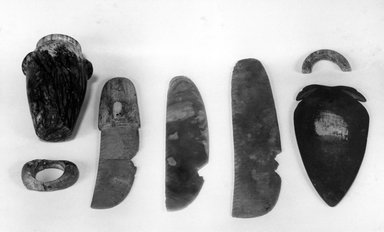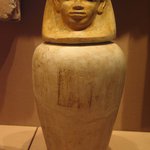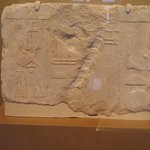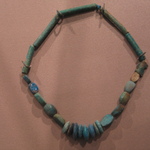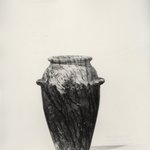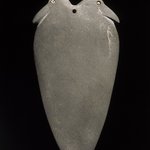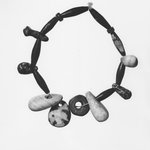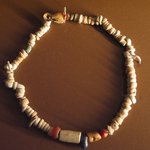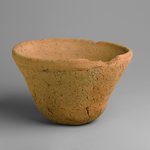Who owned this knife?

Early reports from when this knife was discovered describes the gravesite in rather interesting detail. Based on that description, the owner was relatively richer that others of the same type in the same cemetery location. The field notes doesn't describe the age or sex of the deceased.
This ritual knife was found in a burial site known as Abu Zaidan. Abu Zaidan is deep in Upper Egypt about halfway between Thebes and the First Cataract (Aswan). Given how intricate the carving of this knife is (look closely) we can surmise it was a very wealthy or important person.
What was this used for?

This dagger was probably more for ritual purposes than functional ones. It's very elaborate and therefore not exactly the sort of thing made for everyday. If you look closely at the hilt, there are over two hundred tiny animals carved onto it. It was a decorative sign of status for its owner.
The plaque says to ask for more info. What can you tell me?

I can tell you all sorts of fun things about this ritual knife. To start with, this knife was found at the burial site known as Abu Zaidan, deep in Upper Egypt. Given the intricacy of the carving, it's likely it belonged to a wealthy or important person.
I recommend looking at the incredible detail on the handle. There are carvings of animals including lions, elephants, sheep, giraffes, ibises, Ibexes, dogs, and even honey badgers.
The thumb rest indicates it was meant to be wielded by a right handed person.
It’s called a ritual knife, but there’s nothing on the ritual. Are there any details?
Unfortunately not. Archaeologists guess that this and other knifes like it served a ritual function because of the large amount of decoration. However, the context in which it was found (in a burial) and shape of the knife itself don't provide enough clues as to what ritual it might have been used in.
Archaeology, especially the farther back you get, especially without writing, can be a lot of trial and error! Informed deductions are sometimes the best we can do!
Is it possibly just an artistic expression, or is there a specific reason to presume religious function? I once read somewhere that in the world of archaeology, “ritual” is code for “Not sure.”
It kind of is! I was trying to be diplomatic but I'm personally inclined to agree on that.
That said, a certain amount of decoration on functional objects does make them hard to use for everyday purposes. Plus the amount of time spent on decoration when someone could be say, farming or performing more important tasks for living, does suggest that the object held enough significance to warrant the time investment.
Ok, thank you for clarifying! :)
What this tool/weapon was used for?

We actually believe it was ceremonial or decorative. The amount
of decoration leads us to believe that it wasn't an object made to endure everyday wear and tear, or warfare.
If you look closely you'll see that there are rows of animals carved into the ivory handle.
Yes we see the rows of animals!
There are actually 227 animals in all on the knife, representing 19 different species. You might be able to pick out some elephants, sheep, and domestic dogs!
One thing I find fascinating is that, based on the shape of the handle, researchers know it was meant for a right-handed person.
My son is in search of giraffe.
Okay! There's one on a piece in the Egyptian galleries, but it's is really tiny! On the third floor there is an ivory knife from ancient Egypt that shows 227 individual animals representing 19 different species (including one giraffe!) carved on it.
There it is! Now there's another part to the challenge: The giraffe is on the opposite side of the handle. It's in the second row from the top, the second animal in from the blade.
Is this blade made of flint? I thought flint was black.

I used to think so too! The term flint is very often used to refer to stone that is darker in color, but it’s really just microcrystalline quartz--quartz with a very fine grain--and therefore comes in a variety of colors. If you’ve heard of chert or jasper, these have the same crystal structure.
The ivory part is the handle.
Ah. Learn something new every time! Thank you
The detail on this knife is crazy. Could you give me some perspective on what else was going on circa 3300 BCE?
That's pretty broad! Some highlights in Egypt were that the government that became a unified ancient Egypt and really taking off and writing was being invented. This could be considered the protodynastic period including kings like Scorpion and Crocodile.
Society was becoming increasingly organized and towns that arose as commercial and religious centers were gaining political control of broader and broader regions.
Whoa. We were just joking about that movie with the Rock.
So were we!



